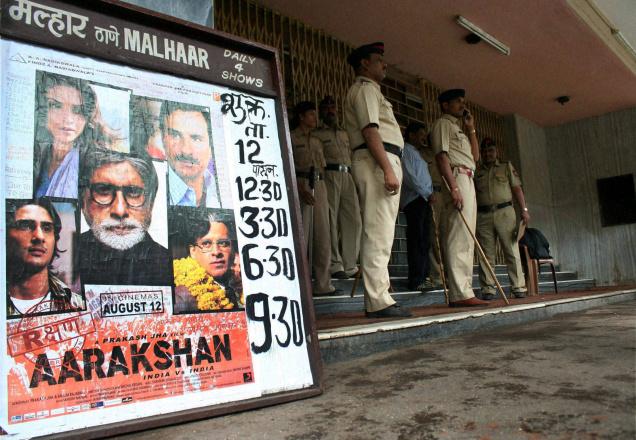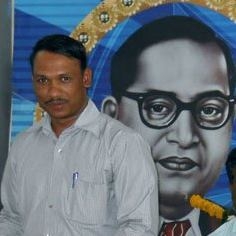by Bobby Kunhu
I have not watched Aarakshan.
I am an unapologetic advocate of free speech.
And I generally do not like writing about what I do not know.
But then this piece is not about Aarakshan, but about dominant discussions about the movie from newsroom discussions to (English) newspaper headlines. And most of the discussants had not watched the movie either.
First things first, let me try and piece together the events that have catapulted Aarakshan to centrestage from my perspective. Around a couple of months back, on the receipt of several complaints, the National Commission for Scheduled Castes (NCSC) requested Prakash Jha, the Director of the film to show the film to the Commission prior to its release. On Jha’s refusal, the NCSC issued a notice to the Central Board of Film Certification (CBFC) asking them to direct Jha to show the film to them before it releases. Instead of showing the film to the NCSC, the CBFC constituted its own committee to review the film and cleared the film on 20th July and officially refused NCSC’s directive. Perhaps CBFC sought legal advice, for it did show the film to NCSC on the 10th of August, two days before the film was slated for release and on the day before the High Court of Mumbai refused to admit a petition demanding a special pre-release screening of Aarakshan, and stay of the release of the film for possible law and order problems. On the 11th NCSC raised objections to certain scenes in the film and requested the CBFC to review the film prior to its release. On the same day the Government of Uttar Pradesh banned the release of the film and was followed by the Governments of Punjab and Andhra Pradesh. The film was released on 12th August across the country and Prakash Jha approached the Supreme Court for removal of the ban on the same day.
There were two particular discussions that caught my attention. The first one was on the night of the eleventh of August on CNN-IBN and hosted by Rajdeep Sardesai. The discussants included P.L. Punia, Chairperson, NCSC, Leela Samson, Chairperson, CBFC and Suhel Seth (I have no clue who he is except that he religiously appears on television with an opinion on everything under the sun). Sardesai seemed to impute that the NCSC was acting as a super-censor while Punia was trying hard to explain that the NCSC was only doing what it was mandated to do. Both Seth and Sardesai seemed to have difficulty in understanding this. Seth kept trying to assert that CBFC was a statutory body and Punia’s pleas that NCSC was a Constitutional body seemed to fall on deaf ears. Of course, what better can one expect from a couple of commentators who seemed not to be even aware of the bifurcation of the erstwhile SC/ST Commission? Punia’s conjecture that the NCSC might have to resort to action under the Scheduled Castes and Scheduled Tribes (Prevention of Atrocities) Act (PoA) was met with scorn and portrayed as a sign of intolerance to free speech. Leela Samson was at her dignified and diplomatic best acknowledging subtly the protocol hierarchy between NCSC and CBFC, but claiming helplessness due to judicial intervention, hiding the dubious role that CBFC played and at the same time being portrayed as the new messiah of free speech! And of course the moot point of the discussion was the danger to free speech.
The next day – the day of the release of the film – NDTV caught my attention. The host was Vishnu Som and the discussants Kancha Ilaiah, Anupam Kher and Soli Sorabjee. Ilaiah was aggressive, but that did not deter the overflow of prejudice from the other discussants. Som kept on accusing Ilaiah and the Dalit movements of being exclusivist. Anupam Kher was better – when Ilaiah confronted him with castiesm within Bollywood – he claimed that it was a harmonious industry where every community was represented between the spotboy to the star!! But he did one better – especially given that he was the former Chairperson of CBFC – he condescendingly claimed that being a Sarkari body – CBFC had reservation and had representation from all communities. This claim had me rushing to the CBFC website. And voila – out of the fifteen board members – there was one from the scheduled tribes and from Arunachal Pradesh!! Once again the moot point was freedom of speech and expression – the reason why Sorabjee made his cameo appearance. But this time the commitment was proven for what it was – a sham. Because the next topic of discussion was Gordon Brown’s proposal to control social media and the Government of India’s proposal to do the same. This time around Vishnu Som felt that freedom of speech and expression could, if necessary, be compromised in the interest of Law and Order!
The reportage on the same day was also fascinating – in that Prakash Jha and Amitabh Bachchan were portrayed as the victims of a “political” conspiracy – fighting the system all alone. Much was made out about the loss that Jha and team would suffer from the delayed release of the film in three states. As a footnote, almost nothing was said about the enormous savings made in terms of publicity!
There were many things that were disturbing about the discussions. For a media that is otherwise reluctant to discuss caste related issues, it was obvious that “freedom of expression” was just a façade – reservations and upper caste notion of merit were the actual moot points. But even there at least in both the discussion that I watched the Dalit panelists were brought in to be verbally lynched for the purported sins of their community viz. the ban of the movie in three states and more importantly political assertion of their identity. On that account I think the most fitting response came from Chandra Bhan Prasad in the First Post.
But, I would restrict myself to the domain of what I would call the missing legal links.
Firstly – somehow Article 17 of the Constitution of India was missing throughout the discussions. Article 17 abolishes untouchability and is an enforceable right without any limitations and unlike freedom of speech and expression which is one of the freedoms guaranteed under Article 19 and is subject to limitations under the same provision.
Article 17 Abolition of Untouchability – “Untouchability” is abolished and its practice in any form is forbidden. The enforcement of any disability arising out of “Untouchability” shall be an offence punishable in accordance with law.
Article 19 Protection of certain rights regarding freedom of speech, etc. – (1) All citizens shall have the right – (a) to freedom of speech and expression….. (2) Nothing in sub-clause (a) of clause (1) shall affect the operation of any existing law, or prevent the State from making any law, in so far as such law imposes reasonable restrictions on the exercise of the right conferred by the said sub-clause in the interests of the sovereignty and integrity of India, the security of the State, friendly relations with foreign States, public order, decency or morality, or in relation to contempt of court, defamation or incitement to an offence.
One need not be a jurist to compare the language of the two provisions. And legislations such as the PoA Act and the earlier Protection of Civil Rights Act originated in Art. 17 and squarely belong amongst the fetters argued under Art. 19 (2). Even otherwise Art.19 is subject to Art. 17. Let me rephrase this simple piece of legal logic – If Aarakshan violates Art. 17 – In other words promotes or insinuates untouchability – the rights of its authors under Art. 19 (1) (a) is restricted and they can be punished under the PoA Act! Somehow the discursive amnesia of this particular fundamental right even by purported legal luminaries seems to be indicative of entrenched castiesm.
My second concern was flagged off by Punia in the CNN-IBN discussion – but was drowned in the cacophony of pseudo free speech advocacy. The impunity with which the directions of a Constitutional body – NCSC – was ignored by all parties concerned. CBFC is a statutory body established under the Cinematograph Act 1952 and working under the Ministry of Information and Broadcasting. While NCSC is a Constitutional body established under Art. 338 of the Constitution of India answerable to the Parliament through the President of India and Constitutional duties of the Commission include “to investigate and monitor all matters relating to the safeguards provided for the Scheduled Castes under this Constitution or under any other law for the time being in force or under any order of the Government and to evaluate the working of such safeguards;” and “to inquire into specific complaints with respect to the deprivation of rights and safeguards of the Scheduled Castes;” There is absolutely no basis on which the CBFC could ignore/reject a directive from the NCSC in the first place. Nonetheless the almost complete silence (except from the NCSC) on this serious Constitutional lapse is also spurred on by commentators like Suhel Seth who seem to be bent on portraying the NCSC as an institution for political manipulation.
Having said this much, as a conservative Human Rights practitioner, I believe in the indivisibility of rights. Consequently, I also believe that the freedom of speech and expression should be unfettered and banning can never be a solution. The makers of Aarakshan have every right to make and exhibit their film. But if the contents of the film, as alleged, violates Art. 17 or any provision of the PoA Act or any other law in place, I think everyone involved with the making, distribution and exhibition of the film should be prosecuted for each one in the chain would have profited from the illegality!
Bobby Kunhu is a human rights activist and lawyer.
[Image Courtesy: The Hindu]









